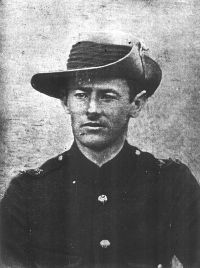Biography – Major George Hatherley Moor
First Western Australia Mounted Infantry
Major George Hatherley Moor, a former captain in the Royal Artillery, was an experienced soldier and leader. A veteran of five years service in Natal with a mountain battery, he also saw service in Rhode's British Charted Company, in Rhodesia (Zimbabwe) and action in the war against the Matabele in 1897.1 He was promoted to the rank of Major on 14 October 1899.2
The Western Australian infantry company of 130 officers, non commissioned officers and men, under the command of Major Moor, left Albany on board the Medic on 7 November 1899, arriving in Cape Town on 27 November. They were accompanied by infantry companies from Victoria, Tasmania, South Australia and Victoria. In Cape Town the companies were amalgamated to form the First Australian Regiment under the command of Colonel J C Hoad of Victoria. This was the first time that a troop representing the various Australian colonies had been formed for active service. The newly formed regiment left for De Aar to join the Kimberley Relief Force and were active in the lines of communication between De Aar and Modder River. Major Moor's company was at Naauwpoort, when it was converted to Mounted Infantry on 1 February 1900.3
Major Moor led his men in operations and actions in Transvaal and the Orange Free State. On 9 February Major Moor led a patrol of Inniskilling Dragoons and more than 20 West Australians, encountering nearly 400 Boers on kopjes east of Slingersfontein. The enemy opened fire, the Dragoons retreated and the Australians kept up the fight until nightfall. The following day General Clements praised Major Moor and his men for their determination in frustrating the enemy's attempt to turn the flank of the position. Major Moor was the officer who rallied the West Australians, and led them in the dash against Botha's rearguard at Diamond Hill, taking part in a running fight lasting some 8 miles. Major Moor and four men were killed in action on 19 July 1900 at Palmietfontein.4
When the news was received in Western Australia, flags were flown at halfmast throughout the colony.
The War Graves & Graves of Conflict Division of The National Monuments Council of South Africa advise that Major Moor was buried at either Palmietfontein where he fell or the farm Karoo Spruit on Rhenosterspruit/Yeomanry Koppie. His remains were disinterred in 1958 to the Lindley Garden of Remembrance, some 20 miles south of where he met his death. He is commemorated on a central monument, listed under his Western Australian regiment.5
1 The Australians at the Boer War, R L Wallace, Canberra 1976.
2 Official Records of the Australian Military Contingents to the War in South Africa, P L Murray, Melbourne, 1911.
3 ibid.
4 The Australians at the Boer War, R L Wallace, Canberra 1976.
5 Information received October 1999 from War Graves & Graves of Conflict Division, National Monuments Council of South Africa, Houghton, South Africa, independent of original database.



